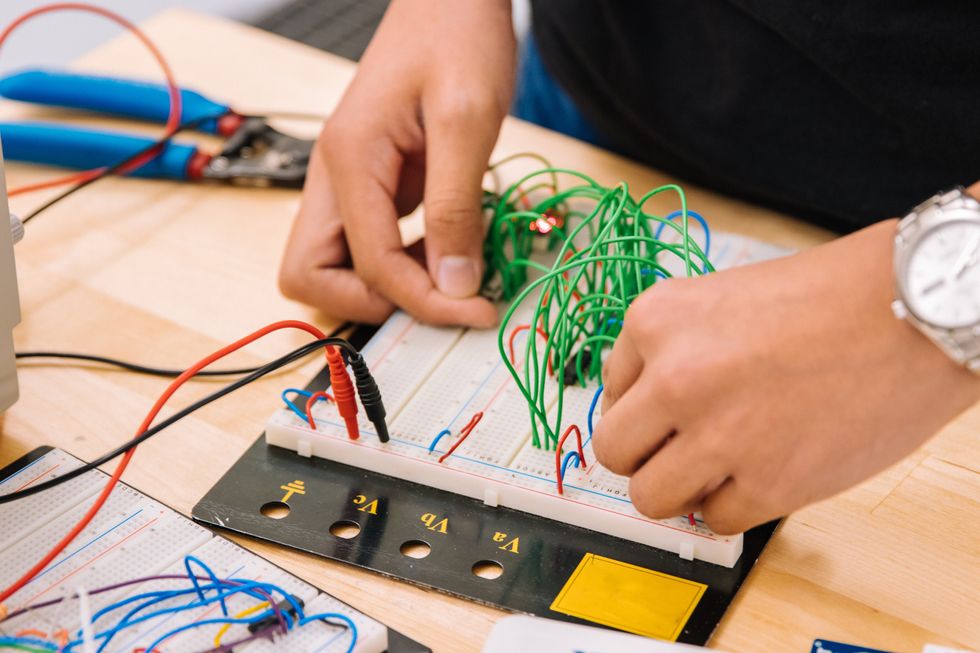With the world transforming at an exceptionally swift speed, children need to learn and grow according to the rapidly changing world so that they don't spend their lives playing catch-up. However, the traditional approach to classroom teaching does not adequately equip young minds to tackle everything that life throws at them.
This method needs to become a thing of the past, and innovative, practical learning must take its place. Some of the preschools are implementing this in their curriculum and their school experience, making the holistic nourishment of a child their focal point. One such method of advanced teaching techniques is the problem-based learning approach.
What is the problem-based learning approach?
Education of every kind requires a problem-based learning approach. In simple words, it means learning through solving a problem. Even the least complicated mathematical equation requires a problem-based approach. The traditional method of teaching also employs the problem-based learning approach when they offer solutions to the problems of several subjects.
However, the problem is that they skip the most intrinsic element of this method, which is helping the students in the stage of problem formulation. The traditional way of teaching requires teachers to hand out solutions and formulas to solutions without offering the students a chance to develop their questions and formulate their answers by themselves.
This method only equips the students to ace the examinations, if they are good at memorizing the information. It does not allow them the chance to apply it to their lives. Problem-based learning offers a system of discovery that helps students internalize their lessons and use them when the time arrives.
The Origin
Problem-based learning finds its roots in the Progressive movement of the early 20th century. John Dewey believed that education should appeal to the students' instincts to investigate and create. It is when educators offer students something to do rather than something to learn that natural and practical teaching takes place.
In John Dewey's words, the problem-based learning approach is,
"To organize education so that natural active tendencies shall be fully enlisted in doing something, while seeing to it that the doing requires observation, the acquisition of information, and the use of a constructive imagination, is what needs to be done to improve social conditions."
Even after almost a century, Dewey's words stand true.
What is a problem-based learning school?
Schools all over the world adopt this method of pedagogy to improve their efficiency and the students learning. Children who are going to be our future require the development of a problem-solving attitude to succeed in this rapidly changing world. Problem-based learning schools inculcate a habit of thinking, researching and solving within the students with minimal aid from an adult. These are vital abilities that every child should possess but are missing out on due to the traditional teaching approach opted for by most schools.
A problem-based learning school aims for a higher standard and achievement by asking students to demonstrate their abilities in a working environment rather than merely echoing what has been taught to them. This technique is not only helpful for bright students. They are inquisitive about the world but are also proven to be motivating for uninterested students by raising their understanding and helping with their achievements.
The educator creates these strategies by keeping every student's capacity and interests in mind and offering them the creativity and independence to choose their calling. Problem-based learning schools are instrumental in building critical-thinking skills and develop a sense of ownership and confidence within the students towards their work.
What happens in a classroom of a problem based learning school?
Since problem-based learning schools are free from the stringent rules of a traditional teaching approach, the classroom becomes a place for interaction, communication and wholesome growth of each child. In the class, learning leaders engage the students in active learning strategies, while the learners initiate and manage most of their activities. The teacher, i.e. the learning leader, acts as a guide to the students, offering them room to employ their creativity and problem-solving skills to their activities.
The textbook becomes a reference for information, but it is featured among other sources such as the Internet as well as community members. Problem-based learning schools often offer increased flexibility to the learning leaders to facilitate the teaching-learning process. They allow educators to structure courses according to the need of the students, especially in the formative years.
The classroom is not usually an enclosed space in problem-based learning schools. Instead, the world becomes a classroom for young learners. They help them in building analytical skills while developing a unique bond with the environment and so have open learning spaces.
Problem-based learning is the need of the hour in the world of education to prepare students for the 21st century.



 women in street dancing
Photo by
women in street dancing
Photo by  man and woman standing in front of louver door
Photo by
man and woman standing in front of louver door
Photo by  man in black t-shirt holding coca cola bottle
Photo by
man in black t-shirt holding coca cola bottle
Photo by  red and white coca cola signage
Photo by
red and white coca cola signage
Photo by  man holding luggage photo
Photo by
man holding luggage photo
Photo by  topless boy in blue denim jeans riding red bicycle during daytime
Photo by
topless boy in blue denim jeans riding red bicycle during daytime
Photo by  trust spelled with wooden letter blocks on a table
Photo by
trust spelled with wooden letter blocks on a table
Photo by  Everyone is Welcome signage
Photo by
Everyone is Welcome signage
Photo by  man with cap and background with red and pink wall l
Photo by
man with cap and background with red and pink wall l
Photo by  difficult roads lead to beautiful destinations desk decor
Photo by
difficult roads lead to beautiful destinations desk decor
Photo by  photography of woman pointing her finger near an man
Photo by
photography of woman pointing her finger near an man
Photo by  closeup photography of woman smiling
Photo by
closeup photography of woman smiling
Photo by  a man doing a trick on a skateboard
Photo by
a man doing a trick on a skateboard
Photo by  two men
two men  running man on bridge
Photo by
running man on bridge
Photo by  orange white and black bag
Photo by
orange white and black bag
Photo by  girl sitting on gray rocks
Photo by
girl sitting on gray rocks
Photo by  assorted-color painted wall with painting materials
Photo by
assorted-color painted wall with painting materials
Photo by  three women sitting on brown wooden bench
Photo by
three women sitting on brown wooden bench
Photo by 
 Photo by
Photo by  Photo by
Photo by  Photo by
Photo by  Photo by
Photo by 


 people sitting on chair in front of computer
people sitting on chair in front of computer



 all stars lol GIF by Lifetime
all stars lol GIF by Lifetime two women talking while looking at laptop computerPhoto by
two women talking while looking at laptop computerPhoto by  shallow focus photography of two boys doing wacky facesPhoto by
shallow focus photography of two boys doing wacky facesPhoto by  happy birthday balloons with happy birthday textPhoto by
happy birthday balloons with happy birthday textPhoto by  itty-bitty living space." | The Genie shows Aladdin how… | Flickr
itty-bitty living space." | The Genie shows Aladdin how… | Flickr shallow focus photography of dog and catPhoto by
shallow focus photography of dog and catPhoto by  yellow Volkswagen van on roadPhoto by
yellow Volkswagen van on roadPhoto by  orange i have a crush on you neon light signagePhoto by
orange i have a crush on you neon light signagePhoto by  5 Tattoos Artist That Will Make You Want A Tattoo
5 Tattoos Artist That Will Make You Want A Tattoo woman biting pencil while sitting on chair in front of computer during daytimePhoto by
woman biting pencil while sitting on chair in front of computer during daytimePhoto by  a scrabbled wooden block spelling the word prizePhoto by
a scrabbled wooden block spelling the word prizePhoto by 
 StableDiffusion
StableDiffusion
 StableDiffusion
StableDiffusion
 StableDiffusion
StableDiffusion









